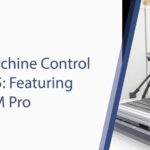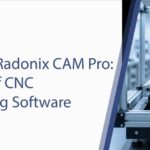In the fast-paced world of modern manufacturing, technology is the engine that drives progress. But no matter how advanced a machine becomes, its true potential is only unlocked by the person operating it.
The bridge between human and machine is the Human-Machine Interface (HMI). A well-executed HMI design for manufactured devices is not just a digital dashboard; it is a critical component that dictates productivity, ensures safety, and defines the overall user experience.
It’s the difference between a frustrating, error-prone workflow and a seamless, intuitive operation.
For too long, HMI design in manufacturing was an afterthought, resulting in clunky, confusing interfaces that required extensive training and created constant frustration.
Today, a superior HMI design for manufactured devices is a strategic asset. It’s the central nervous system of a machine, providing operators with the real-time data and control they need to make smart decisions quickly.
At Radonix, we specialize in robust, user-centric control systems that power the most effective HMIs on the market.
This in-depth article will explore the core principles, the business benefits, and the best practices of HMI design for manufactured devices.
We’ll show why a thoughtful approach to HMI is not just aesthetics, but a crucial investment in the future of your manufacturing operations.
The Foundation: What is HMI Design in Manufacturing?
At its simplest, HMI design is the process of creating the user interface and overall experience for an industrial machine. It encompasses everything from the physical layout of buttons and screens to the digital menus, graphics, and real-time data displays.
A great HMI design for manufactured devices is a master of communication—it speaks the operator’s language, anticipates their needs, and provides a clear, accurate window into the machine’s state.
The goal of HMI design is to:
- Simplify Complexity: Take the thousands of data points and complex operations of a machine and present them in a logical, easy-to-understand format.
- Enhance Usability: Make the machine intuitive to operate, reducing the learning curve for new employees and minimizing errors.
- Promote Safety: Clearly communicate machine status, potential hazards, and emergency information to the operator at all times.
- Improve Efficiency: Provide operators with the tools and information they need to perform tasks faster and more accurately.
In an industrial setting, HMI design is a unique discipline. It must balance a high level of functionality with the realities of a factory floor—noise, dirt, varying light conditions, and operators who need to make critical decisions in an instant.
Core Principles of HMI Design for Manufactured Devices
Creating an effective HMI requires a deep understanding of the operator’s needs and the industrial environment. The best HMI design for manufactured devices is guided by a few key principles.
1. Simplicity and Clarity Above All
The interface should be immediately understandable. Every button, icon, and data point should have a clear purpose. Avoid cluttered screens and overly technical jargon. Use simple, universally recognized icons and color schemes to convey information instantly.
For example, green for “running,” yellow for “warning,” and red for “error” is a simple, effective visual language that requires no explanation.
The goal is to provide a comprehensive view of the machine’s status at a glance.
2. A User-Centric and Context-Aware Approach
A great HMI isn’t built for a machine; it’s built for the person using it. A user-centric design process involves understanding the operator’s skill level, their daily tasks, and the environmental factors they face.
Does the operator wear gloves? Is the factory floor dusty or wet? Is the HMI viewed from a distance? The answers to these questions should influence the size of buttons, the legibility of text, and the robustness of the physical screen.
The best HMI design for manufactured devices is contextual and adapts to the operator’s needs.
3. Immediate and Actionable Feedback
An operator needs to know exactly what the machine is doing, especially when a command is executed.
The HMI should provide immediate visual or audible feedback for every interaction. When a button is pressed, it should change color or provide an audible click.
When an operation is complete, a clear “Task Complete” message should be displayed. Crucially, the system must provide instant, actionable alerts for any alarms or errors, guiding the operator on how to resolve the issue safely and efficiently.
4. Consistency in Design and Function
Consistency is key to a low-stress, error-free user experience. The layout, navigation, and visual language of the HMI should be consistent across all screens, menus, and even across different machines within the same factory.
When an operator learns one interface, they should be able to intuitively navigate another. This reduces the learning curve for new employees and builds a sense of familiarity and trust with the equipment.
5. Ergonomics and Physical Accessibility
HMI design extends beyond the screen. The physical placement of the interface, the size and responsiveness of the touchscreen, and the accessibility of emergency controls all fall under the umbrella of HMI. The design should minimize physical strain on the operator, allowing for comfortable and efficient use throughout a long shift.
The Strategic Benefits of Superior HMI Design
Investing in a well-designed HMI design for manufactured devices offers a significant return on investment that touches every aspect of a manufacturing business.
Increased Productivity and Efficiency
A logical, easy-to-use HMI drastically reduces the time it takes to set up a job, change settings, and troubleshoot issues.
Operators can make decisions faster and with greater confidence, which leads to shorter cycle times and higher overall throughput.
The ability to monitor machine status at a glance and quickly identify bottlenecks is a direct contributor to improved productivity.
Enhanced Operator Safety
An HMI is a vital safety tool. With clear alarms, real-time status indicators, and intuitive emergency controls, it can provide critical information in an instant.
A good HMI design for manufactured devices ensures that operators are always aware of potential dangers, helping to prevent accidents and protect both personnel and equipment.
Drastically Reduced Operator Error
A confusing interface is a breeding ground for mistakes. An intuitive HMI, on the other hand, guides the operator through each step of a process, making it difficult to perform an action incorrectly. By minimizing human error, the HMI saves time, reduces material waste, and prevents costly machine damage.
Simplified Training and Maintenance
A user-friendly interface simplifies the onboarding process for new employees. Less time is spent training on a complex system, and more time is spent on productive work. For maintenance staff, a well-designed HMI with clear diagnostic tools and alarm histories makes it faster and easier to identify and resolve issues.
Key Elements of an Effective HMI Design for Manufactured Devices
When looking for a new HMI solution, consider these key elements that define a superior design.
- Intuitive Layouts: Screens should be organized logically, with the most critical information front and center.
- Graphical & Visual Data: Instead of a long list of numbers, a great HMI uses graphs, charts, and animations to visualize complex data like spindle load, temperature, and tool path.
- Robust Alarm Management: The system should not just display alarms but also organize them by priority, provide clear explanations, and log historical data for analysis.
- Customizable Dashboards: The ability for different users or different jobs to have customized dashboards ensures that the most relevant information is always visible.
- Connectivity and Scalability: A modern HMI should be able to integrate with other systems on the factory floor (IIoT), allowing for remote monitoring and data sharing.
The Radonix Advantage: Your Partner in HMI Design
At Radonix, we believe that the best HMI is one you don’t have to think about—it just works. We specialize in providing high-performance industrial CNC control systems that are the foundation of effective HMIs. Our focus is on creating a user-centric experience that is both powerful and simple.
Our solutions are built with:
- Robust, Industrial-Grade Hardware: Our hardware is designed to withstand the harsh conditions of a manufacturing environment.
- Intuitive and Powerful Software: We develop HMI software that is easy to use, highly customizable, and rich with features like advanced data visualization and robust alarm management.
- Expert Support: We don’t just sell technology; we provide a partnership. Our team works with you to design and implement a custom HMI solution that meets your specific needs.
The right HMI design for manufactured devices is a critical component of a successful, modern manufacturing operation. It is a strategic investment in the safety of your people, the efficiency of your processes, and the quality of your products.
Ready to design an HMI that empowers your team and your operations? Contact Radonix today to learn more about our advanced HMI solutions.
Contact Us:
- E-Mail: info@radonix.com
- Phone: +90 (553) 920 5500








